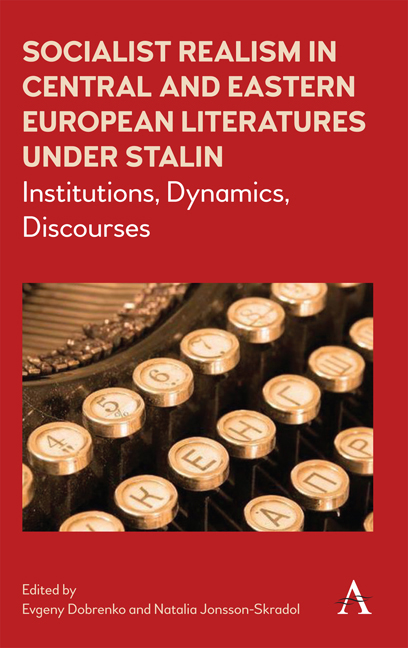 Socialist Realism in Central and Eastern European Literatures under Stalin
Socialist Realism in Central and Eastern European Literatures under Stalin Book contents
- Frontmatter
- Contents
- Acknowledgements
- Introduction
- Part 1 Institutions
- 1 How Socialist Realism Was Exported to Eastern European Countries and How They Got Rid of It
- 2 Literary Monopolists and the Forging of the Post–World War II People's Republic of Letters
- 3 Once Dr Faul Has Left: The Agony of Socialist Realism in Poland, 1955–56
- 4 From Literature Censored by Poets to Literature Censored by the Party: Censorship in the Czech Literary Culture of 1945–55
- 5 The Demise of ‘Socialist Realism for Export’ in 1947: VOKS Receives John Steinbeck and Robert Capa
- 6 The Soviet Factor and the Institutionalization of Bulgarian Literature after World War II
- 7 Cultural Renewal in Eastern Germany – Mission Impossible for Soviet Cultural Officers and German Anti-Fascists?
- Part 2 Dynamics
- Part 3 Discourses
- Conclusion
- List of Contributors
- Index
1 - How Socialist Realism Was Exported to Eastern European Countries and How They Got Rid of It
from Part 1 - Institutions
Published online by Cambridge University Press: 10 May 2018
- Frontmatter
- Contents
- Acknowledgements
- Introduction
- Part 1 Institutions
- 1 How Socialist Realism Was Exported to Eastern European Countries and How They Got Rid of It
- 2 Literary Monopolists and the Forging of the Post–World War II People's Republic of Letters
- 3 Once Dr Faul Has Left: The Agony of Socialist Realism in Poland, 1955–56
- 4 From Literature Censored by Poets to Literature Censored by the Party: Censorship in the Czech Literary Culture of 1945–55
- 5 The Demise of ‘Socialist Realism for Export’ in 1947: VOKS Receives John Steinbeck and Robert Capa
- 6 The Soviet Factor and the Institutionalization of Bulgarian Literature after World War II
- 7 Cultural Renewal in Eastern Germany – Mission Impossible for Soviet Cultural Officers and German Anti-Fascists?
- Part 2 Dynamics
- Part 3 Discourses
- Conclusion
- List of Contributors
- Index
Summary
This chapter concerns debates that took place in Eastern Europe during the 1950s and 1960s that, as I believe, played a crucial role in the cultural development of the region after the war. More specifically, this is a story about how Eastern European writers tried to come to terms with socialist realism and how they strove to get rid of it. For purposes of practical convenience, ‘Eastern Europe’ refers here to all the countries that were under Soviet hegemony after the war, including the German Democratic Republic and Czechoslovakia; discussion on the issue of Central Europe is beyond the scope of this chapter.
First of all, it is important to clarify the very definition of the socialist realist canon – a topic that Evgeny Dobrenko and I treated in Sotsrealisticheskii kanon. Canonical formations are among the strongest cultural mechanisms of stabilization, selection and exclusion. On the one hand, they form protective barriers against the ever- changing flow of time and, on the other, they select and channel various currents of tradition. Socialist realism belongs to the so- called strong canons, wherein the mechanism of automatization and disautomatization – which, according to the Russian Formalist school, dominates the evolution of literature – does not work the usual way because the canon is stabilized by ideological, religious or other strict views.
Elsewhere, I introduced a model of successive stages of the Soviet socialist realist canon. First, there is the protocanon that, since the nineteenth century, was the textual reservoir of the canon proper – suffice it to mention authors like Chernyshevskii and later on Gorky or Gladkov. During the subsequent phase (1928– 34) the canon was formulated in a more or less rigid way. The normative system of socialist realism, with its founding postulates – such as revolutionary romanticism, typicality, partiinost’, narodnost’ and so forth – came into being in the first half of the 1930s. Very soon after the first Writers’ Congress of 1934 it became obvious that these regulative demands aimed at establishing state control over literature, at getting rid of elements of ‘degeneration’ that in the 1936 campaign and in the post- war zhdanovshchina came to be associated with formalism and naturalism.
- Type
- Chapter
- Information
- Socialist Realism in Central and Eastern European Literatures under StalinInstitutions, Dynamics, Discourses, pp. 17 - 24Publisher: Anthem PressPrint publication year: 2018


